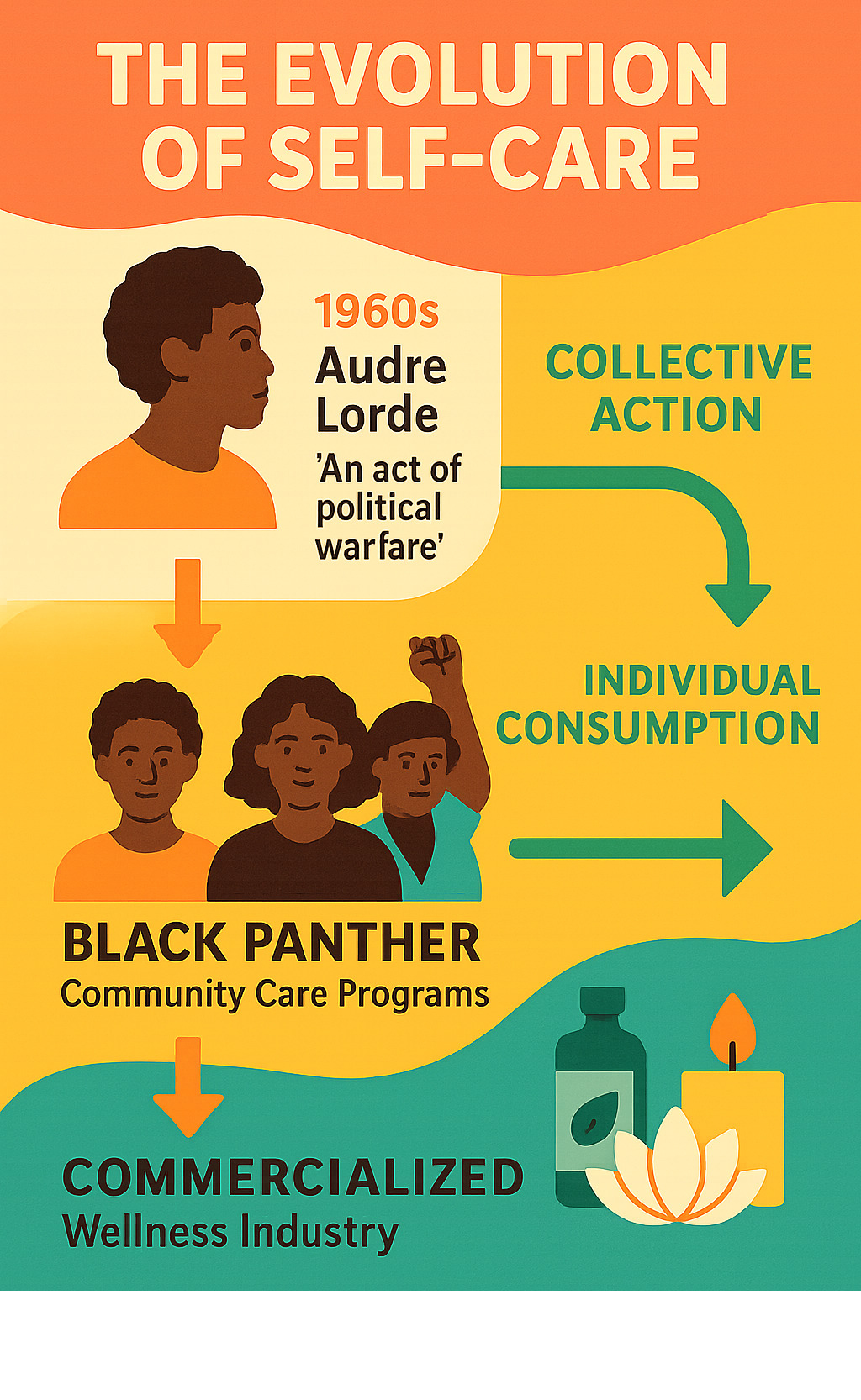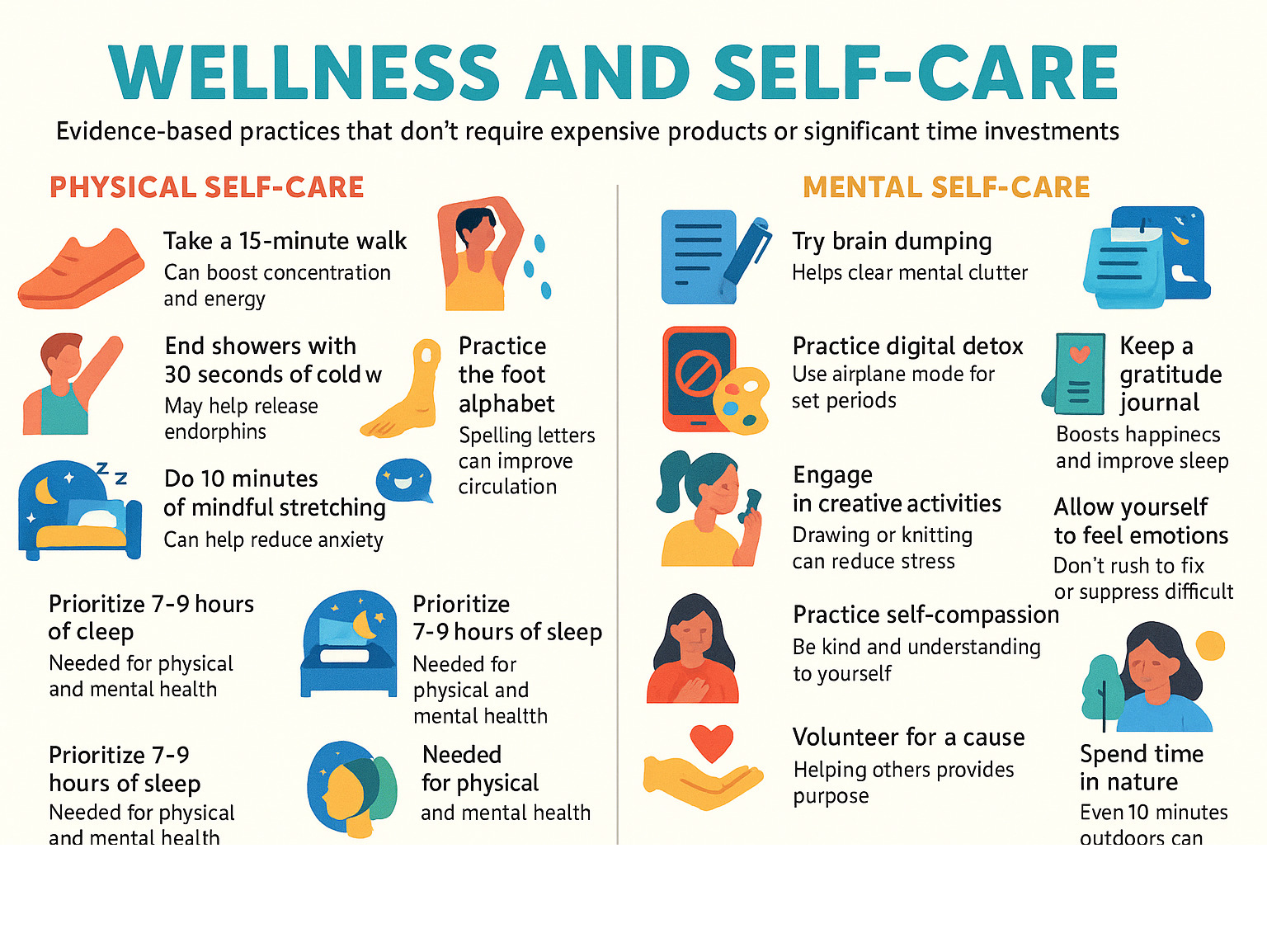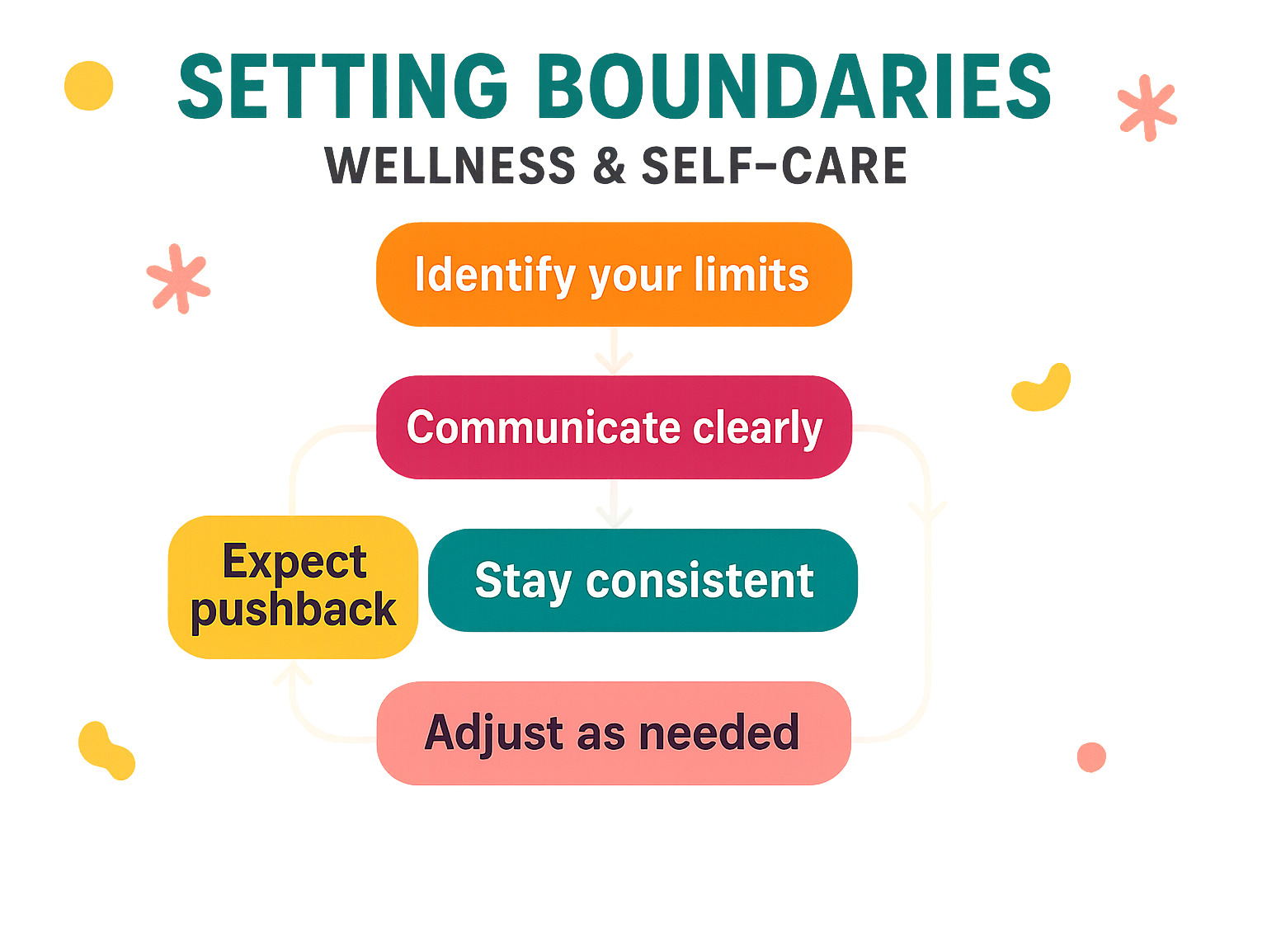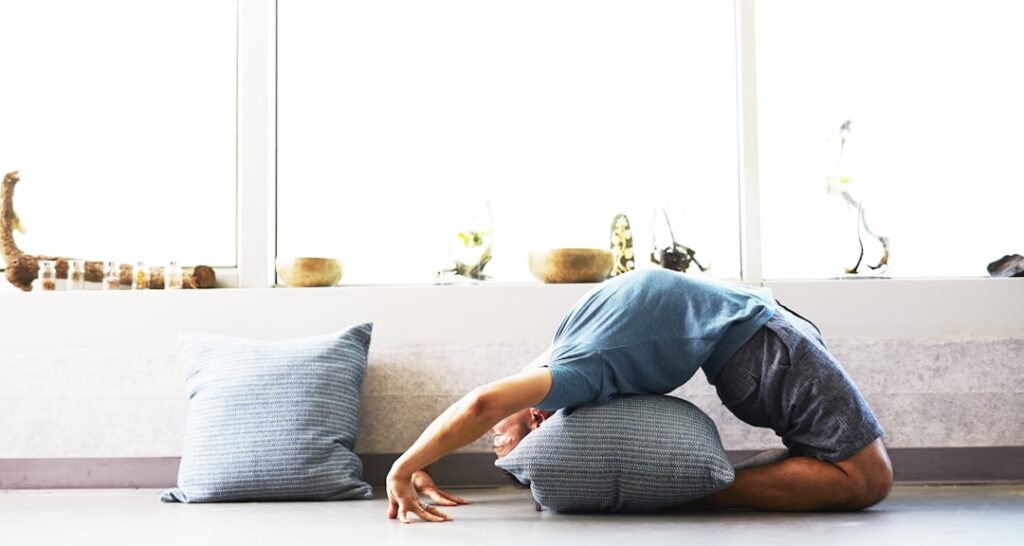Why Wellness and Self Care Matter More Than Ever
Wellness and self care have become essential practices for navigating our increasingly stressful world, but much of what we see online is actually “faux self-care” that keeps us buying products instead of building real resilience.
Quick Answer: Real Self-Care Essentials
– Physical: 7-9 hours sleep, 15-minute daily walks, hydration
– Mental: Boundary setting, saying no, digital detox breaks
– Emotional: Gratitude journaling, processing feelings, seeking support
– Social: Face-to-face connections, community involvement
– Spiritual: Values reflection, purpose alignment, meaning-making
With over 60 million Instagram posts tagged #SelfCare and a $4.4 trillion global wellness industry, the message is everywhere. But here’s what the research reveals – women report higher levels of burnout than men, and nearly twice as many women suffer from anxiety. One in five women ages 40-59 are prescribed antidepressants.
The problem isn’t that we need more face masks or detox teas. Most of what gets marketed as “self-care” is actually faux self-care – quick fixes that boost your mood temporarily but don’t address the underlying systems draining your energy.
Real self-care, as psychiatrist Audre Lorde originally defined it, is “an act of political warfare” – it’s about creating sustainable practices that help you thrive, not just survive. It’s less about bubble baths and more about boundary setting, value alignment, and building genuine resilience.

Learn more about wellness and self care:
– mental health and wellness
– simple self care for therapists
– why is it important
What Is Real Self-Care?
Real wellness and self care has nothing to do with the perfect morning routine you see on Instagram or expensive face masks filling your bathroom cabinet.
Back in the 1960s, poet and civil rights activist Audre Lorde said “self-care is not self-indulgence, it is self-preservation.” She wasn’t talking about bubble baths – she was talking about survival in the face of systemic oppression.
The Black Panther Party understood this deeply. They created community care programs that recognized something revolutionary: individual wellness can’t be separated from collective liberation. They knew that taking care of yourself was actually an act of resistance against systems designed to break you down.
Today, consumer culture has transformed self-care from a tool of empowerment into a marketing strategy. What we’re left with is “faux self-care” – temporary mood boosters that keep you buying products instead of building real resilience.
The difference between faux and real self-care comes down to this: faux self-care treats symptoms, while real self-care addresses root causes. Face masks might make you feel pampered for an hour, but setting boundaries with that energy-draining friend will actually change your life.
Real wellness and self care requires psychological flexibility – the ability to adapt your responses based on what each situation actually demands. It’s about developing the internal resources to steer life’s challenges, not just escape from them temporarily.
This means making value-aligned decisions even when they’re uncomfortable. It means addressing systemic workplace stress instead of just buying another planner. It means building genuine community connections instead of curating the perfect self-care aesthetic for social media.
The Self-Care Litmus Test
Before you adopt any self-care practice, run it through these three questions:
Does this give me energy or drain it? Real self-care should leave you feeling more energized and resilient over time.
Is this sustainable long-term? Effective self-care becomes a natural part of your life, not something that requires constant willpower or breaks your budget.
Does this align with my actual values? Real self-care should feel authentic to who you are and what matters most to you – not what looks impressive to others.
If you’re ready to build sustainable routines that actually work for busy lives, our Simple Self-Care for Therapists guide offers practical, evidence-based strategies that go beyond typical self-care advice.
The Rise of Wellness and Self Care
The explosion of wellness and self care content isn’t happening by accident. It’s our collective response to living in a world that feels increasingly overwhelming. When the wellness industry has ballooned to $4.4 trillion by 2020, you’re seeing millions of people desperately seeking relief.
The statistics paint a troubling picture, especially for women. A comprehensive Canadian study found that women consistently report higher levels of burnout than their male counterparts. The University of Cambridge found that women are nearly twice as likely to struggle with anxiety disorders. Between 2015 and 2018, one in five women aged 40-59 were prescribed antidepressants in the United States.
These numbers reflect something deeper than individual struggles. Women often carry what researchers call the “mental load” – that invisible, exhausting work of remembering everyone’s schedules and managing household tasks. Layer on workplace pressures and caregiving responsibilities, and the appeal of self-care content makes perfect sense.
Why “Wellness and Self Care” Went Viral
Google searches for “self-care” spiked right after the 2016 U.S. election, revealing how political stress drives people to seek coping strategies. The pandemic added fuel to this fire with unprecedented isolation, job insecurity, and health fears.
As the concept went viral, it shifted away from its original meaning. What started as a practice of resistance became something you could buy, consume, and perform for others online.
The gender gap in wellness marketing is particularly telling. The industry figured out that women were feeling overwhelmed, then convinced them that individual self-care products could solve problems much bigger than any face mask could handle – things like workplace discrimination or unequal household labor.
Common Myths the Industry Sells
The commercialized wellness world has created harmful myths that keep us buying instead of healing. The biggest lie is that self-care equals spending money. In reality, the most powerful practices – setting boundaries, prioritizing sleep, taking walks – don’t cost a penny.
There’s also the perfectionist myth that you need the ideal routine to see benefits. The truth? Sustainable wellness and self care adapts to your messy, real life.
Perhaps most damaging is the myth that self-care is selfish. This keeps many women from taking care of themselves because they’ve been taught everyone else’s needs come first. But when you’re running on empty, you can’t show up fully for anyone.
Finally, the industry wants you to believe that products can fix systemic problems. Sometimes real self-care means having difficult conversations, changing jobs, or seeking professional help – not just buying another wellness product.
How to Create Your Self-Care Compass
Creating meaningful wellness and self care isn’t about copying someone else’s Instagram routine – it’s about building something that fits your life and values. Think of it as creating your personal compass that guides you toward what truly nourishes you.
Start with honest self-assessment using SAMHSA’s eight dimensions of wellness: emotional, environmental, financial, intellectual, occupational, physical, social, and spiritual. For each dimension, ask: What’s working well? Where do you feel drained? What’s one small change that could make a real difference?
When setting goals, make them SMART: Specific, Measurable, Achievable, Realistic, and Timely. Instead of “I should exercise more,” try “I’ll take a 15-minute walk after lunch on Monday, Wednesday, and Friday this week.”
Adaptability is crucial. Your self-care needs will shift with life circumstances, and that’s normal. Your compass should be flexible enough to guide you through all seasons of life.
Map Your Values & Set Boundaries
Learning to set boundaries is often the most powerful thing you can do for your well-being, but it’s also the hardest for many of us.
Start with a time audit for one week. Track how you spend your time and how each activity makes you feel. You might find that certain commitments consistently drain your energy without providing meaningful benefits.
Saying no becomes easier when you remember that every “no” to one thing is a “yes” to something else – often your own well-being. The guilt you feel when setting boundaries is normal, but it’s not a sign you’re doing something wrong. It’s often a sign you’re doing something necessary.
If you’re struggling to find time for self-care in a packed schedule, our 5-Minute Wellness Tips for Busy Women offers practical strategies that work in real life.
Personalized “Wellness and Self Care” Plan
Your self-care plan should feel as unique as you are. A busy parent needs different strategies than a college student or retiree. Consider your lifestyle-fit honestly. If you’re not a morning person, don’t force yourself into a 5 AM routine.
Your cultural-context matters too. Some practices that work in individualistic cultures might not resonate if you come from a more community-oriented background. The goal is finding approaches that feel authentic to who you are.
Don’t forget your support-network. Research consistently shows that social connections are crucial for mental and physical health. Who genuinely supports your well-being? How can you strengthen those relationships while identifying any that drain your energy?
20 Science-Backed Self-Care Ideas That Cost Little or Nothing
Here are evidence-based wellness and self care practices that don’t require expensive products or significant time investments:
Physical Self-Care:
1. Take a 15-minute walk – Research shows this can boost concentration and energy throughout the workday
2. End showers with 30 seconds of cold water – A 2007 study found cold exposure helps release endorphins with potential antidepressant effects
3. Do 10 minutes of mindful stretching – One controlled trial showed this can help reduce anxiety
4. Practice the foot alphabet – Spell out letters with your feet in bed each morning to improve circulation
5. Prioritize 7-9 hours of sleep – Adults need this amount for optimal physical and mental health
Mental Self-Care:
6. Try brain dumping – Write down all your thoughts for 3 minutes without lifting your pen to clear mental clutter
7. Practice digital detox – Put your phone on airplane mode for set periods
8. Engage in creative activities – Draw, knit, or work with your hands to reduce stress
9. Learn something new – Read challenging material or watch documentaries to stimulate your mind
10. Practice micro-meditations – Even 5 minutes of meditation can improve focus and reduce stress
Emotional Self-Care:
11. Keep a gratitude journal – Science shows gratitude can boost happiness and improve sleep while lowering depression and anxiety
12. Give and receive hugs – Research on physical touch shows it can improve well-being and lessen pain, depression, and anxiety while lowering cortisol levels
13. Call a friend or family member – Social connection is medicine for mental health
14. Practice self-compassion – Speak to yourself as kindly as you would to a good friend
15. Allow yourself to feel emotions – Don’t rush to fix or suppress difficult feelings
Social Self-Care:
16. Accept JOMO (Joy of Missing Out) – Cancel one non-essential plan each week to recharge
17. Volunteer for a cause you care about – Helping others can provide perspective and purpose
18. Send a gratitude text – Thank someone who has made a difference in your life
19. Find a walking buddy – Combine social connection with physical activity
20. Spend time in nature – Even 10 minutes outdoors can reduce stress and improve mood

Quick “Wellness and Self Care” Habits for Busy Days
When time is extremely limited, these micro-practices can still make a difference:
- Take three deep breaths before starting a challenging task
- Stretch at your desk for 30 seconds every hour
- Step outside for 2 minutes of fresh air and sunlight
- Drink a glass of water mindfully instead of gulping it down
- Put your phone in another room during meals
- Say one thing you’re grateful for before getting out of bed
Social & Community Boosters
Self-care isn’t just individual – community connection is essential for well-being. Consider these approaches:
- Join or create a walking group in your neighborhood
- Start a book club focused on wellness or personal growth
- Organize potluck dinners to combine social connection with nourishment
- Participate in community gardening to connect with nature and neighbors
- Attend local support groups for shared challenges or interests
The connection between beauty and mental health is particularly important to understand. Our guide on Beauty and Mental Health explores how self-care practices can improve both inner and outer well-being.
Setting Boundaries, Managing Guilt, and Tweaking Your Routine
The biggest enemy of sustainable wellness and self care isn’t lack of motivation – it’s the perfectionism trap. You start a beautiful routine, miss a few days when life gets hectic, then abandon it entirely because you “failed.”
Here’s the truth: real self-care is messy, flexible, and forgiving. If you miss your morning meditation, those three deep breaths at your desk still count. The magic happens in the adjustments, not the perfection.
Progress tracking should feel supportive, not like surveillance. Notice patterns in your energy levels. When do you feel most drained? What activities actually restore you? This self-awareness becomes your compass for tweaking your routine.
Habit stacking makes new practices stick without relying on willpower. Attach your new self-care habit to something you already do automatically. “After I brush my teeth, I’ll write down one thing I’m grateful for” works better than vague intentions.
But let’s address the elephant in the room: guilt. If you’re used to putting everyone else’s needs first, setting boundaries can feel selfish. That uncomfortable feeling isn’t a sign you’re doing something bad – it’s a sign you’re making necessary changes.
Boundary-setting often triggers pushback from others, which can intensify your guilt. People who benefit from your over-giving might resist your new limits. This is normal and doesn’t mean you should abandon your boundaries.

Reframe guilt as growing pains. When you feel guilty about saying no or taking time for yourself, remind yourself that you’re not being selfish – you’re being responsible. Taking care of yourself ensures you can show up fully for what matters most.
Watch for burnout warning signs: chronic exhaustion that sleep doesn’t fix, increased irritability, feeling disconnected from activities you usually enjoy, or physical symptoms like headaches. These signals mean it’s time to reassess, not push harder.
When Your Routine Isn’t Working
Sometimes your self-care routine stops feeling nourishing. You might be going through the motions without experiencing benefits, or your routine starts feeling like another to-do item.
Here’s when it’s time for a refresh: you feel stressed about maintaining your practices, everything feels mechanical rather than restorative, your life circumstances have changed significantly, or you’re experiencing persistent symptoms.
Conduct an honest energy audit. Keep a simple mood log for one week, noting your energy levels and what preceded your highest and lowest points. You might find that your 6 AM yoga practice drains you because you’re not a morning person.
Your self-care needs will evolve, and that’s normal. What worked during a calm period might not serve you during stress. Honor where you are now, not where you think you should be.
Professional support becomes necessary when individual practices aren’t enough to address persistent mental health challenges, workplace harassment, toxic relationships, or other systemic issues. If you’re struggling with ongoing concerns, the SAMHSA National Helpline at 1-800-662-4357 provides free, confidential support 24/7. Seeking professional help isn’t a failure of self-care – it’s an extension of it.
Frequently Asked Questions about Wellness and Self Care
What if I don’t have time or money for self-care?
The most powerful self-care practices are completely free and take less time than scrolling through social media. Setting a boundary by saying no instantly gives you time without spending a penny. Taking three deep breaths, stepping outside for thirty seconds, or drinking your coffee mindfully can be done in under a minute.
If you’re genuinely overwhelmed, start with the “big three”: adequate sleep, basic nutrition, and brief moments of stillness. A well-rested, nourished person has more energy than someone running on empty, regardless of expensive supplements.
When we’re most stressed about not having time for self-care, we often waste time on activities that drain rather than restore us. A quick time audit usually reveals pockets of time that could be redirected toward practices that actually help.
How do I know a self-care trend is evidence-based?
With so much wellness content online, here’s your filter: look for practices backed by peer-reviewed research rather than testimonials or influencer endorsements.
Be skeptical of anything promising quick fixes, requiring expensive products, or using vague language like “detox.” Real science is specific about what was studied and what the results showed.
Evidence-based wellness and self care practices share certain characteristics: they’ve been studied in controlled trials, benefits build over time rather than promising instant results, they can be adapted to different circumstances, and they don’t rely on purchasing specific products.
Can self-care replace therapy or medical care?
The answer is a clear no. Self-care is a valuable complement to professional treatment, never a replacement.
Think of self-care like regular car maintenance – oil changes and tire rotations help your car run smoothly. But if your engine is making strange noises, you need a mechanic, not just an oil change.
If you’re experiencing persistent symptoms of depression, anxiety, or other mental health conditions, please seek professional support. Self-care practices can improve the effectiveness of therapy and medical treatment, but they work alongside professional care, not instead of it.
Wellness and self care should make you feel more capable of handling life’s challenges, not more isolated. If your routine is adding pressure rather than relief, it might be time to talk with a professional.
Conclusion
True wellness and self care goes far beyond glossy magazines or Instagram feeds. When you prioritize your genuine well-being, set meaningful boundaries, and make decisions that align with your values, you’re doing something revolutionary. You’re not just taking care of yourself – you’re quietly rebelling against a culture that profits from your exhaustion.
This is what Audre Lorde meant when she called self-care “an act of political warfare.” Every time you say no to something that drains you, every time you choose rest over productivity, you’re making a statement about what kind of world you want to live in.
Self-care is a continuous practice, not a finish line. Your life will change, your stress levels will fluctuate, and your needs will evolve. The routine that serves you today might need tweaking next month, and that’s completely normal. The goal isn’t perfect balance – it’s developing self-awareness and flexibility to adapt as life throws you curveballs.
You don’t have to figure this out alone. Community connection remains one of the most powerful forms of self-care. Seek out people who understand that real wellness isn’t about perfect routines or expensive products. Find your tribe of people who value authenticity over performance and celebrate small wins.
At Beyond Beauty Lab, we’ve seen how empowerment comes from understanding that true beauty radiates from practices that honor your whole self. It’s not about perfection or keeping up with trends. It’s about creating a life that feels sustainable and meaningful to you.
Your well-being matters deeply – not just for your own sake, but for the ripple effects it creates in every relationship and interaction. When you take care of yourself in genuine ways, you show up differently for your family, work, and community. You become living proof that there’s another way to move through the world.
For comprehensive guidance on building sustainable wellness practices, explore our Ultimate Guide to Wellness and Well-Being. You’ll find practical strategies for creating lasting change that goes beyond surface-level fixes.
Remember: Your wellness and self care journey is uniquely yours. Trust yourself to know what you need, even when it doesn’t match what everyone else is doing. Start small, be patient with yourself, and celebrate choosing a different path – one that honors your inherent worth and helps you show up as your most authentic self.










